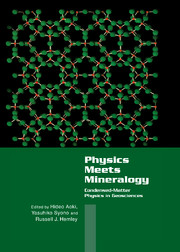Book contents
- Frontmatter
- Contents
- Preface
- List of Contributors
- Part I Introduction
- Part II Advances in Theoretical and Experimental Techniques
- Part III New Findings in Oxides and Silicates
- Part IV Transformations in Silica
- Part V Novel Structures and Materials
- Chapter 5.1 Opportunities in the Diversity of Crystal Structures – A View from Condensed-Matter Physics
- Chapter 5.2 Theoretical Search for New Materials – Low-Temperature Compression of Graphitic Layered Materials
- Chapter 5.3 H…H Interactions and Order–Disorder at High Pressure in Layered Hydroxides and Dense Hydrous Phases
- Part VI Melts and Crystal–Melt Interactions
- Subject Index
- Materials Formula Index
- Index of Contributors
Chapter 5.1 - Opportunities in the Diversity of Crystal Structures – A View from Condensed-Matter Physics
Published online by Cambridge University Press: 05 November 2011
- Frontmatter
- Contents
- Preface
- List of Contributors
- Part I Introduction
- Part II Advances in Theoretical and Experimental Techniques
- Part III New Findings in Oxides and Silicates
- Part IV Transformations in Silica
- Part V Novel Structures and Materials
- Chapter 5.1 Opportunities in the Diversity of Crystal Structures – A View from Condensed-Matter Physics
- Chapter 5.2 Theoretical Search for New Materials – Low-Temperature Compression of Graphitic Layered Materials
- Chapter 5.3 H…H Interactions and Order–Disorder at High Pressure in Layered Hydroxides and Dense Hydrous Phases
- Part VI Melts and Crystal–Melt Interactions
- Subject Index
- Materials Formula Index
- Index of Contributors
Summary
The diversity in crystal structures of materials of interest in condensed-matter physics and mineral sciences is reviewed from the viewpoint that they are an outcome of multiple ways in which building blocks (polyhedra, clusters, chains, layers, etc.) can be arranged in ambient or high pressures. Opportunities for interesting electronic properties expected from unconventional as well as conventional crystal structures are outlined, which may even include electron correlation engineering when those properties arise from the electron correlation.
Introduction
Although quantum mechanics laid a solid foundation for condensed-matter physics earlier this century, we are now witnessing a new era in that branch of physics in which we begin to understand crystal structures in nonempirical ways. As stressed in the Preface of this volume, this has been particularly fruitful in understanding rock-forming minerals. It is indeed fascinating if we can predict crystal structures of minerals or other materials in general from a knowledge of the chemical composition alone. This also opens up a way to search for novel crystal structures, either in denser or open-structured forms.
The purpose of this chapter is twofold. One is to take silica as an example for elaborating on various crystal structures, obtained from a nonempirical computer-simulation study. Silica comprises the two most abundant elements on the Earth, i.e., silicon and oxygen. Silica, along with silicates, is an important ingredient in rock-forming minerals. Crystal-to-crystal phase transformations, as well as pressure-induced amorphisation, are described.
- Type
- Chapter
- Information
- Physics Meets MineralogyCondensed Matter Physics in the Geosciences, pp. 259 - 298Publisher: Cambridge University PressPrint publication year: 2000
- 1
- Cited by



